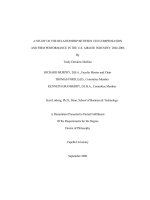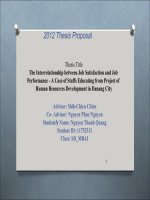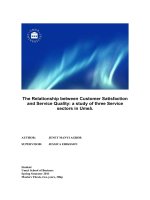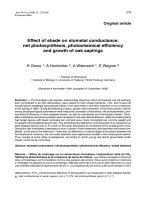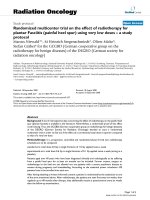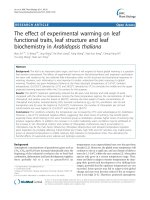The moderating effect of emotional intelligence on the relationship between job satisfaction and affective commitment: a study among employees in Vietnam Banking Industry
Bạn đang xem bản rút gọn của tài liệu. Xem và tải ngay bản đầy đủ của tài liệu tại đây (780.96 KB, 82 trang )
UNIVERSITY OF ECONOMICS HO CHI MINH CITY
International School of Business
Phạm Ngọc Anh Thơ
THE MODERATING EFFECT OF EMOTIONAL INTELLIGENCE ON THE
RELATIONSHIP BETWEEN JOB SATISFACTION AND AFFECTIVE
COMMITMENT: A STUDY AMONG EMPLOYEES IN VIETNAM BANKING
INDUSTRY
MASTER OF BUSINESS (Honours)
Supervisor: Trần Phương Thảo
Ho Chi Minh City – Year 2017
UNIVERSITY OF ECONOMICS HO CHI MINH CITY
International School of Business
Phạm Ngọc Anh Thơ
THE MODERATING EFFECT OF EMOTIONAL INTELLIGENCE ON THE
RELATIONSHIP BETWEEN JOB SATISFACTION AND AFFECTIVE
COMMITMENT: A STUDY AMONG EMPLOYEES IN VIETNAM BANKING
INDUSTRY
MASTER OF BUSINESS (Honours)
Supervisor: Trần Phương Thảo
Ho Chi Minh City – Year 2017
Acknowledgement
I would like to express my deep gratitude to my supervisor Tran Phuong Thao for
her precious guidance, valuable suggestions and advice as well as her immense
knowledge to support me throughout the process.
In addition, I would like to thank my family, my friends and my colleagues for
their constant encouragement and immediate helps without which the study would not
have been possible.
Abstract
The study investigates the influence of job satisfaction facets on affective
commitment in the context of Vietnam banking industry. It also examines the moderating
role of emotional intelligence in the relationship between job satisfaction facets and
affective commitment. The model was tested with a sample of 313 employees working
for banks in Ho Chi Minh city. The result reveals a good fit between collected data and
measurement scales which were introduced and developed in the Western contexts. The
findings shows that job satisfaction facets have positive impacts on affective
commitment, and that emotional intelligence significantly serves as a moderator for three
out of seven facets of job satisfaction and affective commitment relationship. The
discovery highlights the importance of documenting job satisfaction and emotional
intelligence in enhancing the employee commitment towards organization as well as calls
the management attention to their recruiting, training and long term development
policies.
TABLE OF CONTENTS
ACKNOWLEDGEMENT
ABSTRACT
TABLE OF CONTENTS
1.
Introduction .........................................................................................................................................................1
1.1. Background of the study ....................................................................................................................................1
1.2. Research problem ...............................................................................................................................................3
1.3. Research objectives ............................................................................................................................................5
1.4. Scope of the study. .............................................................................................................................................5
1.5. Significance of the study ....................................................................................................................................6
2. Literature review .....................................................................................................................................................7
2.1. Foundational theories .........................................................................................................................................7
2.2. Affective commitment ........................................................................................................................................8
2.3. Emotional intelligence ........................................................................................................................................9
2.4. Job satisfaction. ................................................................................................................................................ 12
3. Hypothesis development ........................................................................................................................................ 13
3.1. Job satisfaction and affective commitment ....................................................................................................... 13
3.2. Emotional intelligence and affective commitment ........................................................................................... 15
3.3. Emotional intelligence as a moderator ............................................................................................................. 16
4. Research methodology........................................................................................................................................... 19
4.1. Procedure and sample ....................................................................................................................................... 19
4.2. Questionnaire design ........................................................................................................................................ 21
4.3. Measurement scale ........................................................................................................................................... 21
4.4. Data analysis .................................................................................................................................................... 22
5. Result ...................................................................................................................................................................... 23
5.1. Sample profile .................................................................................................................................................. 23
5.2. Measurement refinement .................................................................................................................................. 24
5.3. Measurement models: ...................................................................................................................................... 26
5.3.1. Correlations analysis ................................................................................................................................ 26
5.3.2. Hierarchical regression analysis .............................................................................................................. 27
5.4. Discussion ........................................................................................................................................................ 31
5.4.1. Theoretical implication ............................................................................................................................. 32
5.4.2. Managerial implication............................................................................................................................. 33
5.5. Direction for further studies and limitations..................................................................................................... 34
5.6. Conclusion........................................................................................................................................................ 35
References .................................................................................................................... Error! Bookmark not defined.7
Appendix .................................................................................................................................................................... 37
Appendix 1: Questionnaire survey – English version. ............................................................................................ 37
Appendix 2: Questionnaire survey – Vietnamese version ....................................................................................... 39
Appendix 3: Scale reliability assessment with Cronbach’s alpha (N=313) - Affective commitment scale ............ 44
Appendix 4: Scale reliability assessment with Cronbach’s alpha (N=313) – Emotional intelligence scale ............ 44
Appendix 5: Scale reliability assessment with Cronbach’s alpha (N=313) – Job satisfaction scale - Pay .............. 45
Appendix 6: Scale reliability assessment with Cronbach’s alpha (N=313) – Job satisfaction scale - Promotion ... 46
Appendix 7: Scale reliability assessment with Cronbach’s alpha (N=313) – Job satisfaction scale - Supervisors . 46
Appendix 8: Scale reliability assessment with Cronbach’s alpha (N=313) – Job satisfaction scale – Fringe benefits
................................................................................................................................................................................. 47
Appendix 9: Scale reliability assessment with Cronbach’s alpha (N=313) – Job satisfaction scale – Co-workers 47
Appendix 10: Scale reliability assessment with Cronbach’s alpha (N=313) – Job satisfaction scale – Nature of
work ........................................................................................................................................................................ 48
Appendix 11: Scale reliability assessment with Cronbach’s alpha (N=313) – Job satisfaction scale Communication ....................................................................................................................................................... 49
Appendix 12: Scale reliability assessment with Cronbach’s alpha (N=158) – pilot study ...................................... 49
Appendix 13: Scale reliability assessment with Cronbach’s alpha (N=158) – pilot study ...................................... 50
Appendix 14: Scale reliability assessment with Cronbach’s alpha (N=158) – pilot study-Job satisfaction facets Pay........................................................................................................................................................................... 51
Appendix 15: Scale reliability assessment with Cronbach’s alpha (N=158) – pilot study-Job satisfaction facets Promotion ................................................................................................................................................................ 51
Appendix 16: Scale reliability assessment with Cronbach’s alpha (N=158) – pilot study-Job satisfaction facets Supervisors .............................................................................................................................................................. 52
Appendix 17: Scale reliability assessment with Cronbach’s alpha (N=158) – pilot study- Job satisfaction facets Fringe benefits ......................................................................................................................................................... 52
Appendix 18: Scale reliability assessment with Cronbach’s alpha (N=158) – pilot study- Job satisfaction facets –
Operating condition ................................................................................................................................................. 53
Appendix 19: Scale reliability assessment with Cronbach’s alpha (N=158) – pilot study- Job satisfaction facets Co-workers .............................................................................................................................................................. 53
Appendix 20: Scale reliability assessment with Cronbach’s alpha (N=158) – pilot study- Job satisfaction facets Nature of work ........................................................................................................................................................ 54
Appendix 21: Scale reliability assessment with Cronbach’s alpha (N=158) – pilot study - Job satisfaction facets Communication ....................................................................................................................................................... 54
Appendix 22: Exploratory factor analysis (EFA) - Affective commitment ............................................................ 55
Appendix 23: Exploratory factor analysis (EFA) - Emotional intelligence ............................................................ 56
Appendix 24: Exploratory factor analysis (EFA) – Job satisfaction ....................................................................... 57
Appendix 25: Normal distribution of residuals ....................................................................................................... 60
Appendix 26: Homoscedasticity test ....................................................................................................................... 61
Appendix 27: Hierarchical regression analysis with emotional intelligence is a moderating value ........................ 62
Figure 1. The conceptual model................................................................................................................................ 19
Figure 2. Moderating effect of emotional intelligence on the relationship between nature of works and
affective commitment……………………………………………………………………………………………….39
Table 1: Demographic statistics................................................................................................................................ 22
Table 2: Cronbach’s Alpha analysis ........................................................................................................................ 26
Table 3: Correlations................................................................................................................................................. 27
Table 4: Hierarchical Regression Analysis with Emotional intelligence as a moderating variable ................... 30
Table 5: Result Summary……………………………………………………………………………………..…....39
AFFECTIVE COMMITMENT AMONG BANK STAFFS
1
1. Introduction
The first part of the study is devoted to emphasizing the practical and theoretical
importance of studying affective commitment, job satisfaction, emotional intelligence
and the relationships among them. Besides, the study desires to present the interest in the
topic in the context of Vietnam banking. The final section is the summary of objectives
which is followed by the scope of the study.
1.1. Background of the study
Human resource has been considered as one of the most valuable asset of any
organization. According to Ferrary (2015), human capital has a direct relationship to
organizational performance in terms of company’s profit and targets. Other studies found
that maintaining a stable labour force is an optimal way to obtain effective cost
management and enhance quality of service in a firm (Jago & Deery, 2002) as well as
achieve sustainable economic development of a nation (Bousrih, 2013).
The concept of organizational commitment has been studied by many researchers
over the last three decades. Diversity of factors were found to have significant
relationships with organizational commitment namely: Job satisfaction, job performance,
job stress, work attitude, organizational justice, tenure, gender educational level, turnover
intention, etc. (Mathieu & Zajac, 1990; Meyer &Allen, 1999). Affective commitment the strongest component among three commitments has received considerable attention
from researchers all over the word. Being considered as a representative of organizational
commitment, affective commitment has demonstrated its significant role in most of the
AFFECTIVE COMMITMENT AMONG BANK STAFFS
2
relationships related to employee’s engagement (Carmeli, 2000). Understanding the
associations of these factors with organizational commitment, especially affective
commitment, is important for improving the employee performance and enhancing
employee productivity as well.
In order to expand the knowledge of this issue, numerous of new approaches have
been undertaken to contribute to organizational commitment literature. Lately, emotional
intelligence has captured the considerable attention from researchers of various fields. It
was explored to have a vital role in explaining variety of potential outcomes such as
academic achievement, human physical and mental health, social support, overall wellbeing (Meisler, 2013). Additionally, emotional intelligence has played its special function
as a mediator or a moderator which helps a wide array of studies obtain deeper insights
into many relationships. Clarke and Mahadi (2011) observed the linkage between leadermember exchange and a plethora of work-related outcomes, eventually they discovered
that emotional intelligence – as a moderating effect, kept an important role in explaining
the variation of each specific pair of constructs. Emotional intelligence was also found to
have significant influence on the stressor-mental health relation (Davis & Humphrey,
2012), the psychological control-behaviour problem relation (Gugliandolo et.al, 2015)or
the stress-burnout relation (Görgens-Ekermans &Brand 2012).
Emotional intelligence was proved to have the moderating effect on relationships
between affective reactions and specific behaviours (Jorden et al., 2002). Accordingly,
previous studies on the job satisfaction – organizational commitment relation have
AFFECTIVE COMMITMENT AMONG BANK STAFFS
3
provided crucial contribution to the theoretical foundation but this is not sufficient to
explain the variation of employee commitment. Based on the research of Jorden and
others, the recent study aims to investigate whether the interaction of emotional
intelligence and job satisfaction predicts affective commitment, in other words, whether
the association between job satisfaction and affective commitment is stronger for
individuals who have high score of emotional intelligence and weaker for ones who
possesses a low level of emotional intelligence.
1.2. Research problem
Since joining the WTO (World Trade Organization) in 2007, Vietnam has
witnessed a significant economic growth in the latest decade due to the improvement of
business environment and the high volume of foreign investments. Along with the
achievement in economy, Vietnam banking industry has also seen an outstanding
enlargement and development in terms of scale and service quality (Leung, 2009),
especially in Hanoi and Ho Chi Minh City.
However, the increases in competition and financial innovation led to an
extremely rapid expansion which resulted in banking system problems in the past few
years. Eventually, the project 254 called “Restructuring credit institutions system 20112015” was implemented by the Prime Minister in 2012. Accordingly, the State Bank
of Vietnam has pushed banks to merge, with the goal of more than halving the number of
lenders. (Lane, 2016). In such an unfavourable condition, labour in this sector has
experienced a considerable fluctuation with the highest average voluntary turnover rate
AFFECTIVE COMMITMENT AMONG BANK STAFFS
4
compared to other service sectors; with the latest figure in 2014 is about 15 % (Thanh,
2015). Restructuring banking sector not only causes the workforce transition among
banks but also between banking and non-banking sectors, accordingly, keeping the
intellectual property for organizations is a crucial strategy for maintaining a sustainable
development.
The literature has showed that a large number of empirical findings on employee’s
commitment, emotional intelligence and job satisfaction originated from Western
countries, this study attempts to widen the implication to a broader scope outside the
traditional samples by testing the relationships among mentioned constructs in the
context of Vietnam. The concept of affective commitment was studied in Vietnam
services industry (Choi, Tran, & Park, 2015), the finding showed a positive relationship
between inclusive leadership and employee work engagement with the mediating roles of
affective commitment and employee creativity. Besides, some empirical studies on job
satisfaction were conducted in Vietnam in recent years: Job satisfaction was tested among
marketers in Ho Chi Minh city by Nguyen and Nguyen (2011), along with job
attractiveness, job satisfaction was found to be positively influenced by firm-specific
marketing capital pool. Job satisfaction was also examined in the association with workfamily conflict in the context of state-owned and foreign invested enterprises (Nguyen,
Jin, Kiong & Fah, 2016). Whilst organizational commitment and job satisfaction have
been taken into consideration in Vietnam for several recent years, little is known about
Emotional intelligence in this small Southeast Asia country. Over all, gaining a deeper
AFFECTIVE COMMITMENT AMONG BANK STAFFS
5
understanding of factors associated with organizational commitment, specifically
affective commitment, what directly and indirectly facilitate or hamper the degree of the
commitment, will help banks to set appropriate human resources policies to encourage
employee’s motivation as well as enhance bank’s performance.
1.3. Research objectives
The study aims to examine the relationship between affective commitment and job
satisfaction’s facets with emotional intelligence in the role of a mixed moderator. Three
specified objectives are given as follow:
(1) The relationship between job satisfaction’s facets and affective commitment.
(2) The relationship between emotional intelligence and affective commitment.
(3) The impact of emotional intelligence on the relationships between job
satisfaction’s facets and affective commitment as a mixed moderator.
1.4. Scope of the study.
The study concentrates on the impacts of job satisfaction on affective commitment
and the mixed moderating effect of emotional intelligence on the relationships, the study
excludes all other elements affecting the variables which potentially influence the results.
Obviously, all the notions studied in this research relates to a wide range of sectors in the
economy, the scope of the study is limited in banking industry.
Moreover, data collection was only conducted in Ho Chi Minh city. Located in a
convenient position, Ho Chi Minh city is known as the most important economic centre
AFFECTIVE COMMITMENT AMONG BANK STAFFS
6
which plays a vital driving impetus of financial, commercial and service hub of the
country. Particularly, the city is home to a large network of banking and financial
institutions. (Tuoi tre news, 2015).For these reasons, Ho Chi Minh city was selected for
the study.
1.5. Significance of the study
In the context of a transitional economy in Vietnam, the banking sector has
suffered from numerous of unfavourable situations came from stock markets, real estate
markets and money market (Vuong, 2014); the turnover in banking segment caused by
such inconvenient conditions has thus increased. Thus, the employment shift prevents
commercial banks from sustainably and stably operating as well as developing in the long
term. Hence, the study is expected to offer a significant contribution to both theoretical
and empirical perspective:
From the academic viewpoint, the study provides insights into emotional
intelligence in the workplace of Vietnamese employees, unfolds the role of
emotional intelligence in moderating job satisfaction-affective commitment
relation and discovers which facets of the job satisfaction have considerable
influences on staffs’ commitment to the bank.
From the practical viewpoint, the findings attract an interest of policymakers in emotional intelligence relating to recruiting, training and
retaining activities. For employees, once emotional intelligence is well
understood and concerned, the ability of managing and controlling
AFFECTIVE COMMITMENT AMONG BANK STAFFS
7
emotions, moods, reactions is thus enhanced. This advantage is expected to
help bank staffs create stronger and more fulfilling relationships in
workplace.
2. Literature review
2.1. Foundational theories
Based on the idea of social exchange theory (Emerson, 1976) which was
conceptualized as a joint activity gained by exchanging the benefits, commitment was
stated to be directly tied to psychological contract in which the employees-organization
relation is driven by a reciprocal obligation between two parties (Sarantinos, 2007).
According to Daan and Sleebos(2006), job satisfaction and organizational commitment
are social exchange outcomes because the two constructs reflect a perception of the
exchange quality of which the employee and the organization are required to fulfill their
obligations to each other and establish ongoing reciprocity.
The Emotional Intelligence theory of Bar-On was first introduced in 1985 and
followed by a series of other subsequent developed versions by Bar-On (2006), Mayer
and Salovey (1990) and Goleman(1998). Even though there are a lot of such different
perspectives in doing research on emotional intelligence, since this construct was
conceptualized, IQ alone has no more dominated as a measure of success.
Emotional intelligence was found to play roles in both building and maintaining
successful social relationships, predicting specific aspects of situations involving social
exchange (Reis et al., 2007). When an organization makes its employees satisfied with
AFFECTIVE COMMITMENT AMONG BANK STAFFS
8
their job, it will in turn obtain the commitment from employees. In this situation,
emotional intelligence will either foster or hamper this exchange process.
2.2. Affective commitment
Organizational commitment is defined the degree of attachment or loyalty
employees feel towards the organisation (Allen & Meyer, 1990; Meyer et al., 2006;
Mowday et al., 1979). It has received considerable attention as a result of its ability to
produce desirable outcomes for organizations. Previous studies suggested that
organizational commitment has the potential link to many outcomes such as job
performance (Mathieu & Zajac, 1990), job satisfaction (Bailey, Albassami & Al-Meshal,
2016; Vandenberg & Lance, 1992), sales (Boles et al. 2007), turnover, absenteeism,
tenure and organizational goals (Baek-Kyoo & Park, 2010; Meyer & Allen, 1999). In
contrast, there was another school of thoughts advocating that the variation of
organizational commitment can be explained by a plethora of antecedents such as job
satisfaction, emotional intelligence, organizational justice, organizational culture,
sociodemographic characteristics etc. (Cohen-Charash & Spector, 2001; Jiang, 2015;
Shalini, 2013; Sikorska-Simmons, 2005)
The study employs the three-component modelof Allen and Meyer (1990) to
examine the bank staffs’ commitment to the banks they are working for. The threecomponent model which was re-conceptualized from numerous definitions has been
broadly used in academic community thanks to its widespread application in various
domains, accordingly, commitment was classified by three distinguishable mindsets
AFFECTIVE COMMITMENT AMONG BANK STAFFS
9
(Allen& Meyer, 1990): Affective commitment refers to the emotional attachment an
employee has towards the organization. Employees with strong affective commitment
stay with the organization because they want to.Continuance commitment reflects an
awareness of the costs of leaving the organization. Finally, normative commitment
reflects a perceived obligation to stay with the organization.
Among three components of commitment, affective commitment was found to be
most important factor compared to continuance and normative commitment (Meyer et al.,
2002). This can be explained by the argument that workers tend to make their own
decision on whether they want to remain with an organization (affective commitment)
rather than they do so for obligation (normative commitment) or financial issues
(continuance commitment). Once employee’s emotional bond to their workplace no
longer exists, they tend to leave for another job instead of staying for any other purposes
(Rhoades et al., 2001). For this reason, the study concentrates on affective assessment to
interpret the job satisfaction-organizational commitment connection. Moreover, since
affective commitment is considered as an emotional attachment between an individual
and an organization (Meyer&Allen, 1999), it is expected to be directly or indirectly
explained by another psychological construct: emotional intelligence in some certain
ways.
2.3. Emotional intelligence
Emotional Intelligence is the ‘ability of an individual to monitor his own and
others’ feelings and emotions, to discriminate among them and to use this information to
AFFECTIVE COMMITMENT AMONG BANK STAFFS
10
guide other individual’s thinking and actions’ (Salovey & Mayer, 1990). Emotional
intelligence has been researched in a number of different ways to examine the
relationships with other work-related factors including transformational leadership,
conflict resolution, political skill, success in job interviews, and job performance (Day &
Carroll, 2004; Joseph & Newman, 2010; Harms &Crede´, 2010; Mayer et al., 2008;
Meisler, 2013) or explain work attitudes and behaviours (Carmeli, 2003; Wong & Law,
2002). Cooper (1997) also pointed out that people having high emotional intelligence can
cope with the organizational problems more effectively than those having low emotional
intelligence. There has been numerous of debates around this topic in the academic
community, research on emotional intelligence thus keep increasing over twenty-five
years with different point of views although they overlap in some facets.
Ability model was initially introduced by Salovey and Mayer in early 1990’s
which measures a set of cognitive abilities: The ability to perceive emotions; the ability to
integrate emotion; the ability to facilitate thought; the ability to understand emotions; and
the ability to manage emotions using Emotional-Intelligence Test (MSCEIT: MayerSalovey-Caruso-Emotional-Intelligence Test). The model continued to be developed by
Wong and Law in 2002 with the scale named Wong and Law Emotional Intelligence
Scale (WLEIS). The model supposes that emotional intelligence originates in childhood
and continue to develop subsequently. The mixed model (Bar-On, 1997) regards
emotional intelligence as a combination of cognitive abilities and personality traits. The
AFFECTIVE COMMITMENT AMONG BANK STAFFS
11
competency model (Goleman, 1998) considers emotional intelligence as being capable of
development in operating within working environment.
The current study opted the ability model to examine the influence of emotional
intelligence on the relationship between affective commitment and job satisfaction. Based
on the theory of Salovey and Mayer (1990), Wong and Law (2002) conceptualized
emotional intelligence as composed of four distinct dimensions called WLEIS (Wong and
Law Emotional Intelligence Scale):Self emotional appraisal (SEA) refers to the
individual’s ability to understand their emotions, other’s emotional appraisal (OEA)
refers to the individual’s ability to recognize and understand other people’s emotion,
regulation of emotion (ROE) refers to ability of people who regulate their emotions
which will enable a more rapid recovery from distresses and use of emotion (UOE) refers
to the ability of individuals to make use of their emotions by directing them towards
constructive activities and enhancing performance.
According to Meisler and Vigoda-Gadot (2014), compared to other tools, WLEIS
has some predominant features: Firstly, it has been tested in different cultures, ethnic and
gender groups by recent studies. Additionally, measure of emotional intelligence
employing WLEIS does not overlap with measure of personality traits. Last but not least,
WLEIS was designed to be used in organizations and it especially plays a vital role in
predicting job satisfaction. For all these reasons, this approach of emotional intelligence
is the best choice to assess this construct in the context of the study.
AFFECTIVE COMMITMENT AMONG BANK STAFFS
12
2.4. Job satisfaction.
Job satisfaction can be defined as the degree to which people like their jobs
(Spector, 1997).Job satisfaction is associated with important work-related and general
outcomes such as higher levels of job performance, organizational commitment;
discretionary activities such as organizational citizenship behavior, and life satisfaction as
well as with lower levels of absenteeism, lateness, and turnover (Bailey, Albassami & AlMeshal, 2016; Judge, Heller & Mount, 2002; Gyekye, & Haybatollahi, 2015;
Wickramasinghe, 2010 ). Lack of job satisfaction results in a poorer performance, more
frequent absenteeism from work, lower work productivity, more serious depression
(Meyer & Allen, 1999)
Job satisfaction is one of the most broadly investigated concept in academic
community in general and in organizational behaviour in particular. Spector (1997)
pointed out that job satisfaction consists pay, promotion, supervisor, marginal benefits,
contingent rewards, areas of activity, colleagues, nature of work, communication.
Examining job satisfaction with different facets, Tett and Mayer (1993) argued that this
construct should be assessed by three components: Satisfaction with career advancement,
satisfaction with supervisors, and satisfaction with co-workers. Likewise, Goetz et al.
(2012) classified job satisfaction into two dimensions: Internal job satisfaction which
refers to an individual’s motivation to willingly perform an assigned task for itself and for
the pleasure it brings, and, external job satisfaction which refers to external benefits
provided by the organization.
AFFECTIVE COMMITMENT AMONG BANK STAFFS
13
Even though global assessment of job satisfaction with first-order construct or
one-item scale usage have been employed in many studies, it is not encouraged to be used
for measuring the concept due to its inaccurate and overestimated assessment (Boles et.
al., 2007). Specifically, every facet may not have the equal effect on an individual’s
satisfaction, one may be highly satisfied with job due to a high satisfaction with salary,
promotion, supervisor... rather than with the work itself. The global or overall approach is
unable to analyse job satisfaction in more details because the survey questions primarily
evaluate one’s general feelings or attitude towards the job, thus it is difficult for Human
resources policies to be set up appropriately. As argued above, the Job Satisfaction
Survey of Spector (1997) including eight-facet assessment was adopted to collect the
respondent’s detailed feelings about the job.
3. Hypothesis development
3.1. Job satisfaction and affective commitment
The relationship between job satisfaction and organizational commitment is not a
new topic in academic community. It has been reported in numerous articles by scholars
all over the world that these two concepts have a positive connection, however, the
investigation results of this association reflected various scientific perspectives.
According to some studies, job satisfaction was regarded as an antecedent to
organizational commitment, in other words, job satisfaction served as a predictor of
organizational commitment (Mowday et al., 1982; Porter et al., 1974)
AFFECTIVE COMMITMENT AMONG BANK STAFFS
14
Conflicting with the above argument, there was another school of thought
suggesting that organizational commitment is an outcome of job satisfaction, and that the
satisfaction can be explained by various degrees of organizational commitment (Bailey,
Albassami, & Al-Meshal, 2015; Baker &Baker, 1999; Laschingeret al., 2001). In the
context of this research, job satisfaction is identified as a determinant to organizational
commitment. In line with the former perspective, the current research supposes that
satisfied employees are more committed to their job as well as to the bank whereas
dissatisfied employees might want to leave the organization if their attitude to the job is
no longer positive.
Although three components of organizational commitment share the similar
impact on an employee’s attachment to the organization, the nature of each commitment
may differ and has the separate meanings. In a study conducted in 2002, Meyer et al.
concluded that affective commitment occupies a greater contribution to employee’s
favourable work behaviours compared with normative and continuance commitment. As
a result, when it comes to organizational commitment, affective commitment alone was
commonly used in majority of studies instead of three types of commitments (Jiang,
2014; Lövblad, Hyder, & Lönnstedt, 2012; Vandenberghe, & Bentein, 2009). This can be
explained by the fact that satisfied employees are committed to the organization for their
emotions rather than obligations or the cost they may pay if leaving. In more detail, when
affective commitment was separately tested in the research of Boles et al. (2007), the
result revealed that different facets of job satisfaction have various degrees of effect on
AFFECTIVE COMMITMENT AMONG BANK STAFFS
15
the dependent variable. Patrick and Sonia (2012) also discovered the significant role of
job satisfaction in explaining 67% the variation of affective commitment.
Consistent with earlier research, this study consumes that eight dimensions of job
satisfaction: Pay, promotion, supervisors, fringe benefits, operation condition, coworkers, nature of work, communication have the positive effects on affective
commitment. Therefore, the first hypotheses were formed as follow:
H1a: Pay is positively related to affective commitment.
H1b: Promotion is positively related to affective commitment.
H1c: Supervisors is positively related to affective commitment.
H1d: Fringe benefits is positively related to affective commitment.
H1e: Operation condition is positively related to affective commitment.
H1f: Co-workers is positively related to affective commitment.
H1g: Nature of work is positively related to affective commitment.
H1h: Communication is positively related to affective commitment.
3.2. Emotional intelligence and affective commitment
According to Wong and Law (2002), employees with high emotional intelligence
are more satisfied with their jobs, enjoy a higher level of job satisfaction, as a result, will
be less likely to leave their jobs. On the contrary, low emotional intelligence employees,
however, are more likely to leave their organizations due to less committed to their
AFFECTIVE COMMITMENT AMONG BANK STAFFS
16
organizations. Drawing from a study of Abraham (2000), emotional intelligence was
found to significantly associate with organizational commitment for most participants,
this association was even stronger than that between job satisfaction and organizational
commitment. In line with Abraham’s finding, Gu¨leryu ¨z et al. (2008) also pointed out
that all the direct path coefficients from dimensions of emotional intelligence to
organizational commitment were significant. However, these findings were explored
along with the discoveries in which either moderators or mediators were included. Hence,
although the direct paths were found significant, R2 was greater with the presence of
moderating and mediating effects.
As previously discussed, among three types of commitment, affective commitment
benefits the organization to a higher degree due to its strongest contribution to the
employee’s favourable work behaviours. Therefore, based on the emotional intelligenceorganizational commitment relationship which was concluded to be significant, the study
desired to examine whether an individual who is good at managing and regulating
emotions is more affectively attached to the organization than individual who has
problems in controlling the feelings? The second hypothesis was thus stated as following:
H2: Emotional intelligence is positively related to affective commitment.
3.3. Emotional intelligence as a moderator
Emotional intelligence has been reported as a moderator in numerous
relationships. Clarke and Mahadi (2011) emphasized the moderating role in their research
between quality of leader-member exchange and a series of work-related outcomes
AFFECTIVE COMMITMENT AMONG BANK STAFFS
17
namely organizational citizenship behaviour, turnover intention, job satisfaction,
organizational commitment, in-role performance andpsychological well-being, the result
after using a hierarchical moderated regression model revealed that the higher relative
scores on emotional intelligence fostered the magnitude of the effect between each pair of
concepts. Moreover, emotional intelligence was discovered to moderate the relationships
between emotional labor and strain, emotional labor efforts and outcomes, emotional
dissonance and work-family conflict, organizational politics and organizational
commitment, etc… (Cheung & Tang, 2012; Gao et al., 2013).
However, these above research heavily connected to the Western background and
received little attention in Asia workplace environment. Cultural differences between the
East and the West have been empirically proved to impact emotion experience and
display (Matsumoto & Hwang, 2012). To be specific, individual achievement and
feelings are valued in Western countries whereas the interdependence of the self and
community is more valued in Eastern countries (Scott-Halsell et al. 2008). This
distinction will to some extent determine individual’s thinking and action of each culture.
Hence, studying emotional intelligence in the context of an Asia nation like Vietnam
should be taken into account for adequate consideration.
The study supposed that the impact of job satisfaction on affective commitment is
stronger when an individual has a higher level of emotional intelligence and vice versa.
Up to the present, the moderating role of emotional intelligence in the relation of job
satisfaction and organizational commitment has not received much attention from
AFFECTIVE COMMITMENT AMONG BANK STAFFS
18
academic community. In order to enrich the organizational behaviour literature, the
current study observed the potential mixed moderating effect of emotional intelligence to
provide a deeper understanding for job satisfaction – affective commitment relation. In
doing so, the interactions of job satisfaction’s facets and emotional intelligence were
added to test this potential effect. The hypotheses were thus developed:
H3a: Emotional intelligence plays a mixed moderating role in the relationship
between pay and affective commitment.
H3b: Emotional intelligence plays a mixed moderating role in the relationship
between promotion and affective commitment.
H3c: Emotional intelligence plays a mixed moderating role in the relationship
between supervisors and affective commitment.
H3d: Emotional intelligence plays a mixed moderating role in the relationship
between fringe benefits and affective commitment.
H3e: Emotional intelligence plays a mixed moderating role in the relationship
between operation condition and affective commitment.
H3f: Emotional intelligence plays a mixed moderating role in the relationship
between co-workers and affective commitment.
H3g: Emotional intelligence plays a mixed moderating role in the relationship
between nature of work and affective commitment.
AFFECTIVE COMMITMENT AMONG BANK STAFFS
19
H3h: Emotional intelligence plays a mixed moderating role in the relationship
between communication and affective commitment.
Figure 1. The conceptual model
4. Research methodology
4.1. Procedure and sample
The study was undertaken through two steps including pilot study (qualitative and
quantitative) at the first stage and main survey (quantitative) at the second stage by
capturing responses of bank staffs of ten banks in Ho Chi Minh City.
The qualitative pilot study involved an in-depth interview with 4 bank staffs. The
interview was implemented to assess the clarity of words, the content of the questions
and the ability to answer the questions of the interviewees. Generally, all the items were
well understood. The quantitative pilot study was then used to test the reliability and
